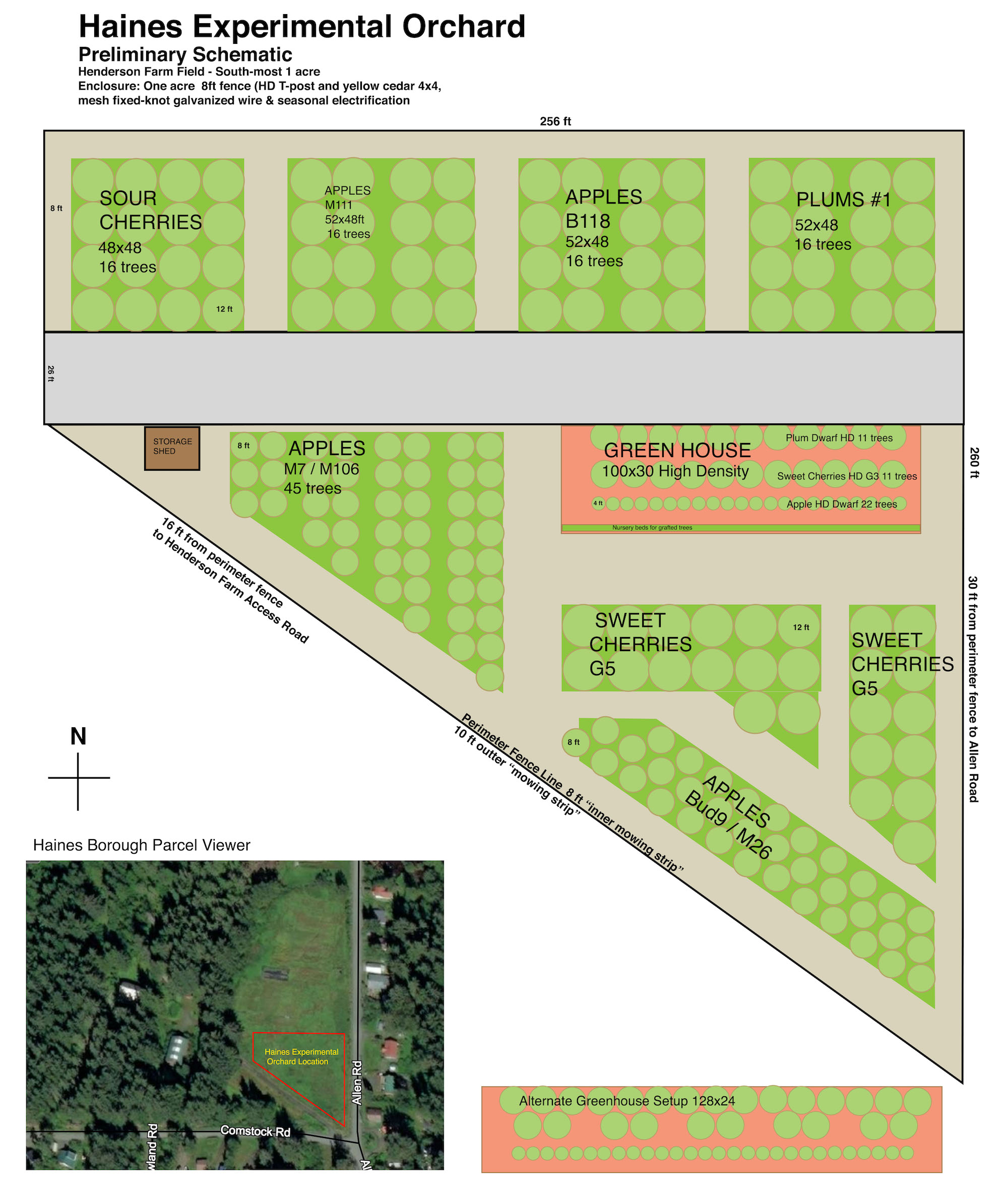An Experimental Orchard for Haines
(Preliminary Schematic Plan at bottom of page)
Overview
With a slowly warming climate, improved fruit cultivars and rootstocks, and Alaska-region horticultural methods, there exists unmet potential for tree fruit cultivation to make greater contributions to the regional economy and food security. Prior to the effort of the Chilkat Valley Orchard Project, there was very little coherent, region-specific literature on fruit tree cultivation. To continue pursuing the project’s food security and economic development goals, the Chilkat Valley Historical Society (CVHS) is partnering with the American Bald Eagle Foundation (ABEF) to establish a one-acre, experimental orchard at Henderson Farm on property owned by the ABEF.
Four Broad Project Objectives
The following objectives have been clearly defined as the basis for a future ABEF-CVHS collaboration:
- Establish a one-acre, fenced experimental orchard on the southern-most portion of the 3.5-acre Henderson Farm property, enclosed within a permanent barrier fence, dedicated to fruit tree experimentation, and guided by a MOA, lease or agricultural easement between CVHS and ABEF.
- Apply and demonstrate regenerative, organic, no/low-till horticultural methods to build the Henderson Farm’s “highly erodible*” soil structure, improve soil fertility, and more closely mimic the forest ecosystem that was removed when the property was cleared in the early 20th Century.
- Create youth programs that exploit the site’s location ¼ mile from Haines School, such as 4H, and FFA, and build a strong volunteer base to catalyze greater community learning and local food security.
- Trial and experiment to determine the best fruit varieties, cultivars, rootstocks and production methods for the northern SE-Alaska region, and identify commercial applications and value-added opportunities.
- *defined as such by the National Resources Conservation Service, Juneau Field Office
Site Planning and Parameters
The promise of greater regional food security, and significantly greater tree fruit production, can only be realized through a coherent program of multi-year experimentation. Participants of the USDA-funded Chilkat Valley Orchard Project who helped draft our preliminary experimental orchard site-plan include: Orchardists Rob Bishop of Hoonah and Blythe Carter of Haines, Orchard Project Manager, Burl Sheldon, and the project’s Professional Support, Darren Snyder, an Associate Professor of Agriculture at UAF. Our knowledge-base is also enriched by decades of experience and the contributions of Haines orchardist, Rob Goldberg, Juneau’s Ed Buyarski, UAF Agronomist, Bob Van Veldhuizen, and the late Michael Phillips, an award-winning author and holistic orchard expert.
Trial Parameters–preliminary draft
- Wildlife Exclusion—Moose and bears have to be entirely excluded. Due to deep snow, tall fencing is a requirement. A barrier fence with a finished height of 8ft would, in time, be electrified.
- Outdoors v. Indoors Trials—Growing fruit in a greenhouse/hoop-house significantly changes what is possible and will be a strong component of the experimental orchard. At a minimum, six-weeks is added to the growing season inside a greenhouse enclosure. The indoor environment also yields significantly higher soil temperatures and more Heating Degree Days, which boosts productivity. Fruit cultivars that are mid-season ripening, such as Honeycrisp apples, that are ripen inconsistently outdoors in Haines, will ripened in a hoop-house. Indoor growing also significantly reduces seasonal fruit damage by birds, squirrels, etc. Given our annual snow-fall, a year-round, permanent, snow-shedding, greenhouse design is a requirement. Indoor trees must be rooted in the ground to access natural water. We are considering a greenhouse design that would provide approximately 3000sq.ft. for growing area and accommodate approximately 40 -60 dwarf trees.
- Fruit Cultivars/Varieties—Generally in our region, only early-ripening tree fruit species and cultivars will produce ripe fruit in our region. Due to our inconsistent winter—prone to spells of mid-season warming—only high chill-hour cultivars will thrive. Below is a general list of species.
Apples: Indoors and Outdoors
Sweet Cherries: Indoors and Outdoors
Sour Cherries: Outdoors only
European Plums: Indoors and Outdoors
Pears: Indoors only
Hazelnuts: Indoors and Outdoors
Others
- Rootstocks—The fundamental growth and precocial nature of a fruit tree—know as vigor—is significantly tied to the genetics of the clonal roots (the rootstock). A tree’s adult size, age at first production, disease resistance and cold-heartiness are rootstock traits. The experimental orchard project will trial different rootstocks, but basis of these trials are proven rootstocks.
- Tree-Spacing— Tree-spacing is among the most important trial parameters. As rootstock vigor is reduced, trees can be spaced more closely. Conversely, larger, more vigorous trees must be spaced farther apart. The experimental orchard will trial various spacing parameters, for the different fruit species, cultivars and their pollination requirements. Inside the greenhouse, trees on dwarf rootstocks can be crowded much closer. Modern, commercial producers in the Lower-48 have successfully push this parameter to the extreme!
- Trellising Indoor Trees–Inside the protective greenhouse, all trees will be severely pruned, trellised and trained to a narrow, two-dimensional shape. Trees planted outdoors generally are free-standing, as branches need to remain flexible to avoid snow damage.
- Mounding—Our soils are relatively young and shallow, even at Henderson Farm. A small lift of soil, or mound, achieves several valuable outcomes: 1) the lift of even just 6-inches gives young trees are quicker start, allowing quick feeder root-spread, without weed competitors; 2) the mound geometry is more conducive to the essential heavy mulching under the drip-line that will occur each spring and fall as the trees grow; 3) based on experience from Hoonah, AK, the mounding helps tree soils drain better and melt-out from winter more quickly.
- Indoor Tree Nursery—Our capricious winter means that a fruit tree nursery needs protection. Youthful trees must be safe from the crush of our snowy winter. The space needed for a compact fruit tree nursery is minimal. A raised-bed just 18 inches wide is enough. Propagating local tree varieties will be supported by the permanent greenhouse.
- Storage for Tools/Equip—Basic tools need a place for storage, plus a work area. A 16’ X 10’ shed is anticipated.
Preliminary Schematic Orchard Plan

